How to Introduce a Feral Cat to a House Cat: Managing the Transition
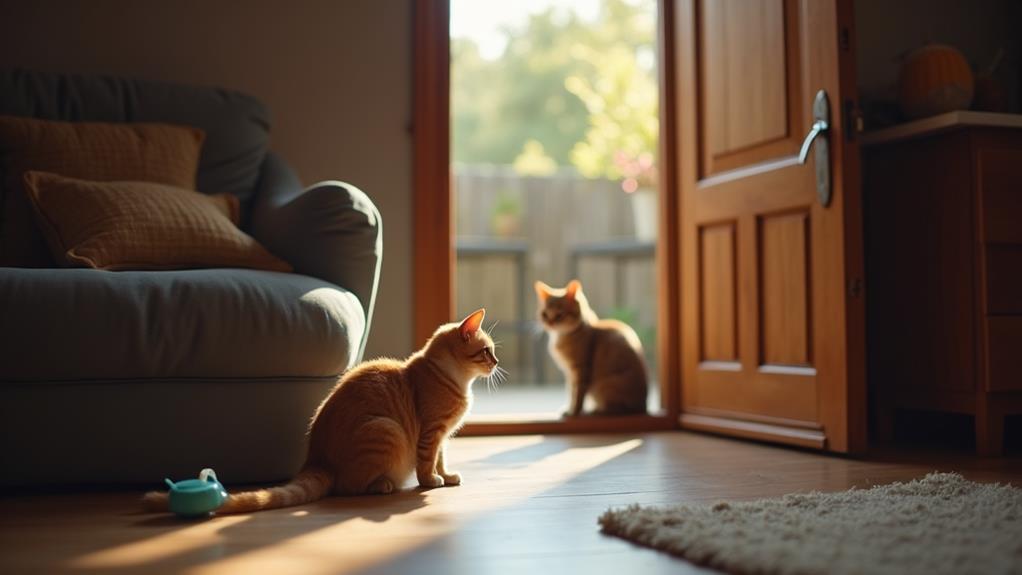
To introduce a feral cat to a house cat, start by creating a safe environment. Designate separate spaces with resources like food, water, and litter boxes for each cat. Use scent swapping by exchanging bedding or toys to familiarize them with each other's scent. Introduce visual contact using a baby gate, and monitor their body language closely. Progress to supervised meet-and-greets and use positive reinforcement to encourage calm interactions. Keep initial meetings short while gradually increasing their duration. Understanding their body language is essential for a successful introduction. Investigate these methods further for a peaceful integration.
Understanding Feral and House Cats
Understanding the fundamental differences between feral and house cats is crucial when introducing them to each other. Feral cats, having been born without human contact, often see humans as threats, unlike the resident cat, who's likely accustomed to human interaction. This difference greatly impacts how both cats will react during their initial encounters. You'll need to recognize that feral cats possess unique personality traits and natural instincts that influence their adaptation to a new environment.
Feral cats can adapt to indoor living and even form bonds with humans, but this change can be challenging. It requires patience and an understanding of their behaviors. Meanwhile, your resident cat may show territorial behaviors when a new cat enters its space, which could lead to stress or aggression if not managed correctly. You'll need to carefully manage this dynamic to guarantee a smooth introduction.
Each cat, regardless of being feral, stray, or a long-time pet, has specific survival instincts and socialization needs. As you begin this introduction process, consider these factors to create a harmonious environment. Understanding these differences will set the stage for a successful change, minimizing potential conflicts between the cats.
Preparing Separate Spaces
With a solid grasp of the differences between feral and house cats, you're ready to focus on creating a welcoming environment for the feral cat. Start by designating a separate room for the feral cat during the initial phase of adjustment. This space helps minimize stress, giving the feral cat time to acclimate without the overwhelming stimuli of their new housemate. It's crucial that this room is equipped with all the necessary resources, such as food, water, and at least two litter boxes.
Provide hiding spots to offer a sense of security, as feral cats typically feel safer when they have a place to retreat. Incorporate familiar scents, like bedding or toys from the feral cat's previous environment, to ease their adjustment into this new space.
Make sure the door to this separate room stays securely closed. This prevents any accidental encounters with the house cat, maintaining a controlled environment for the feral cat's acclimatization. Throughout this period, closely monitor the feral cat's behavior and health. Keeping an eye on their progress guarantees they're adjusting well to their new surroundings before any formal introductions to the house cat occur.
Scent Swapping Techniques
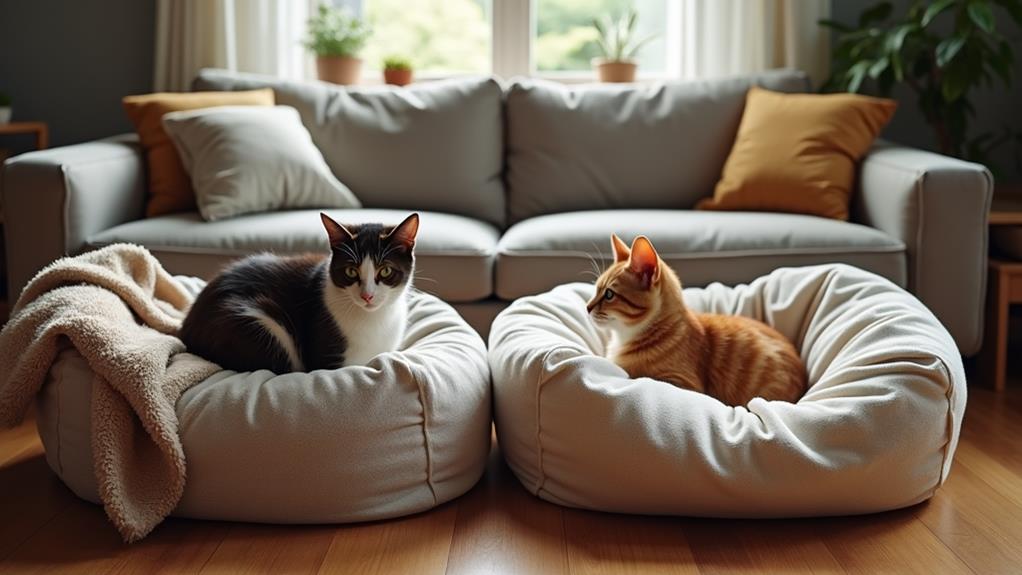
Scent swapping is a gentle and effective method to assist your feral and house cats get accustomed to each other without direct contact. Start by exchanging bedding or toys between your cats. Place a blanket or towel that your feral cat has used in your house cat's space, and do the same with items used by your house cat in the feral cat's area. Allow both cats to investigate these new scents at their own pace.
As you continue with scent swapping, gradually increase the frequency of exchanges every few days. This gradual approach guarantees both cats have ample time to adjust to the new odors, reducing the chances of overwhelming them. Monitor both cats closely for any signs of stress or aggression. Their reactions can provide valuable insights into their comfort levels with each other's scents.
Incorporate positive reinforcement during this process. When either cat shows curiosity towards the exchanged items, offer them a treat. This positive reinforcement helps create a pleasant association with the other cat's scent, making future interactions smoother. By carefully observing and supporting both cats through scent swapping, you're laying the foundation for a successful introduction.
Initial Visual Contact
After a week of scent swapping and separation, it's time to introduce visual contact between your feral cat and house cat. Use a screen door or baby gate to allow them to see each other without direct confrontation. This setup guarantees safety while facilitating the initial visual contact. During these sessions, call each cat by name and offer treats to create positive associations. This encourages calm behavior and helps both cats associate each other's presence with good things.
Supervision is essential during these initial interactions. Monitor body language closely. Look for signs of fear, aggression, or curiosity. If either cat hisses, growls, or flattens their ears, it might be a sign they're not ready. On the other hand, relaxed postures and curious sniffing are positive indicators. Gradually increase the duration of these visual sessions, allowing both cats to acclimate to each other's presence without feeling pressured.
If either cat shows signs of extreme stress or aggression, take a step back. Give them a few more days before attempting another visual introduction. Patience is key to a successful adjustment. Remember, the goal is to make sure both cats feel comfortable and safe throughout the process.
Supervised Meet and Greets
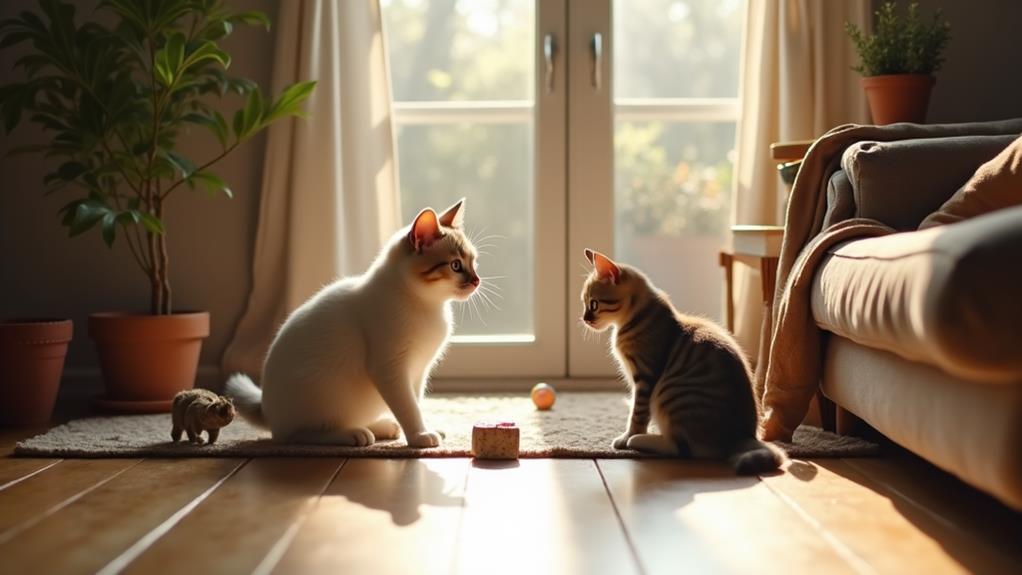
Once both cats seem relaxed during visual contact sessions, it's time to move to supervised meet and greets. This stage should only begin after at least two months of gradual introductions. Start by setting up a secure barrier, like a baby gate, which allows the cats to see and sniff each other without direct contact. This method minimizes the risk of aggression while letting them familiarize themselves further.
During these initial meetings, keep a close eye on each cat's body language. Look for signs of stress or aggression, such as hissing, growling, or flattened ears. If you notice these behaviors, it's essential to pause and possibly revert to previous introduction steps. Patience is vital, as each cat adjusts at its own pace.
Incorporate positive reinforcement to encourage calm and friendly behavior. Offer treats and verbal praise to both cats whenever they interact peacefully. This helps them associate each other's presence with positive experiences. Remember, setbacks are normal, so remain patient and flexible with the process. Building a relationship between a feral cat and a house cat takes time, and these supervised meet and greets are a significant step in ensuring a harmonious coexistence.
Gradual Face-to-Face Time
Introducing face-to-face interactions between a feral cat and a house cat marks a vital stage in their relationship-building process. After at least two months of gradual scent introductions, it's time to introduce a new cat into the house cat's territory through supervised face-to-face interactions. Make certain both cats feel secure and somewhat familiar with each other's presence. Start by gathering tasty treats and using their names to create positive associations during these initial meetings.
Keep the meetings short and sweet initially, gradually increasing the duration as both cats show comfort and curiosity rather than stress or aggression. It's important to be in the room during these sessions, ready to step in and separate them if any hostility arises. Remember, patience is key, and pushing them too fast can lead to setbacks.
Continue providing separate resources like food, water, and litter boxes, keeping territorial disputes at bay. This arrangement helps both cats maintain a sense of security within their shared environment. Gradual face-to-face time, combined with positive reinforcement and patience, can pave the way for peaceful coexistence, transforming your home into a harmonious territory for both cats.
Monitoring Body Language
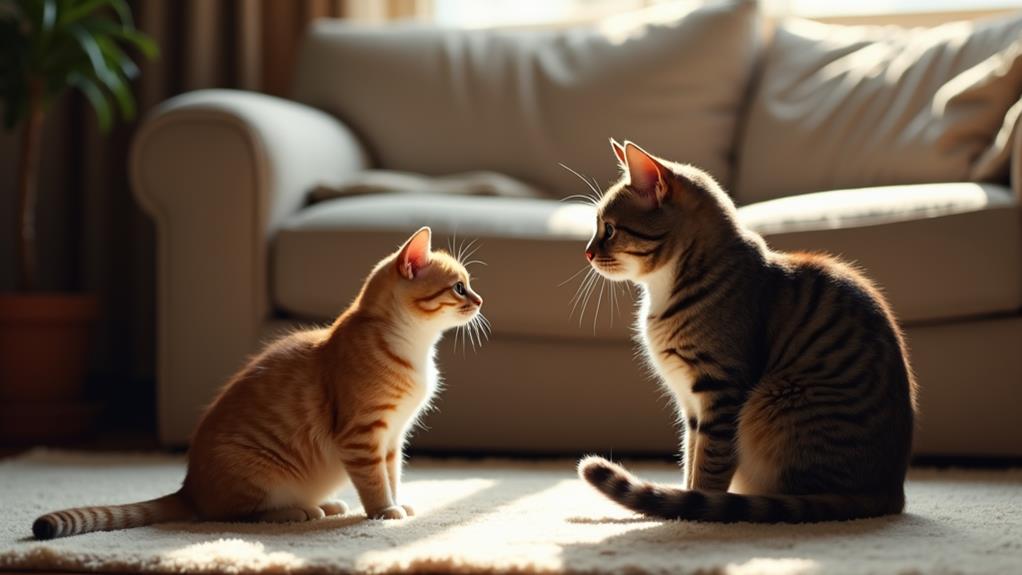
Understanding feline body language is essential when introducing a feral cat to a house cat. You need to pay close attention to signs of stress or aggression, such as flattened ears, dilated pupils, and a puffed-up tail. These indicators suggest that a cat feels threatened and may become aggressive if the situation escalates. Observing these signals allows you to intervene before any conflicts arise.
Comfort levels can be assessed by examining how the cats position themselves. A cat crouching low or hiding is likely fearful, while one standing tall with its tail high is more confident. Slow blinking is an excellent sign, showing trust and comfort around the other cat. If you notice this behavior, it's a positive indicator that the cats are becoming more accustomed to each other's presence.
Keep a close eye on the distance between the cats. A comfortable space helps maintain peace and reduces stress. If either cat hisses, growls, or swats, these are clear signs of aggression, and you should separate them to prevent further issues. By monitoring their body language, you'll be better equipped to manage their introduction smoothly.
Encouraging Positive Interactions
To foster positive interactions between a feral cat and a house cat, you should start with gradual introductions. Begin by allowing the cats to see and smell each other without direct contact through barriers like baby gates or screens. This setup helps them get used to each other's presence safely. Use treats and toys during these initial encounters to create a positive association. Offering treats when they're calm near each other reinforces good behavior and makes them look forward to these meetings.
Engage both cats in play sessions with toys nearby, encouraging a shared positive experience. This can help them associate fun and positive reinforcement with each other's presence. Be attentive to their body language; relaxed signs like slow blinking or a tail held high indicate comfort, while hissing or growling signals stress.
Here's a quick guide to encourage positive interactions:
- Use treats and toys to create favorable associations.
- Gradually introduce visual contact through barriers.
- Encourage joint play sessions with toys for shared experiences.
- Monitor body language for signs of stress or comfort.
If you notice any aggression or stress, don't hesitate to take a step back. Allow more time for gradual acclimatization to guarantee a peaceful change.
Addressing Potential Challenges
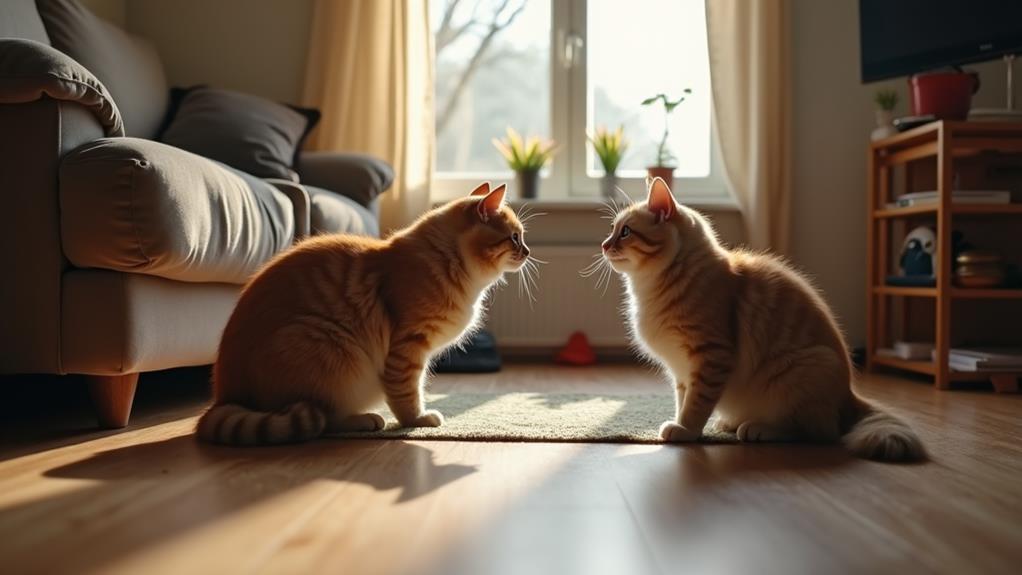
While fostering positive interactions is vital, you'll inevitably face some challenges when introducing a feral cat to a house cat. Stress and aggression are common, especially during initial confrontations, which are significant for shaping future interactions. It's important to monitor both cats' body language closely. Signs of stress, like hissing or defensive postures, indicate the need for further separation. Gradual exposure is key to reducing stress. Start with scent swapping and visual barriers to help both feral and indoor cats become accustomed to each other without direct confrontation.
Ensure you provide multiple resources, such as litter boxes and feeding areas, to mitigate territorial disputes. This approach helps reduce stress and allows each cat to feel secure in their own space. If aggression persists despite these efforts, consult a professional behaviorist or veterinarian. They can offer tailored strategies to address behavioral issues and facilitate a smoother adjustment. Remember, every cat is unique, and what works for one may not work for another. Patience and persistence are your best allies in this process, and with time, you can help both cats coexist peacefully.
Maintaining a Peaceful Environment
How can you maintain harmony when introducing a feral cat to a house cat? Start by ensuring each cat has its own resources, including food, water, and litter boxes. Have at least one extra litter box available to minimize territorial disputes. Your old cat may feel threatened by the arrival of a semi-feral cat, so it's essential to provide separate spaces for both to feel secure.
Create a safe and enriching environment by incorporating hiding spots and raised areas. These give both cats the opportunity to investigate and retreat as needed. Initially, confine the semi-feral cat to a separate room, allowing it to acclimate without overwhelming stress from the resident cat. This gradual introduction helps ease the adjustment for both parties.
Utilize calming remedies like pheromone sprays or natural supplements to promote a peaceful atmosphere. Monitoring interactions closely lets you adjust the environment to maintain comfort and reduce stress.
Here are some practical tips:
- Provide each cat with its own resources, including a litter box.
- Incorporate raised areas and hiding spots for investigation and retreat.
- Use calming remedies to ease the adjustment.
- Monitor interactions and adjust the environment as needed.




